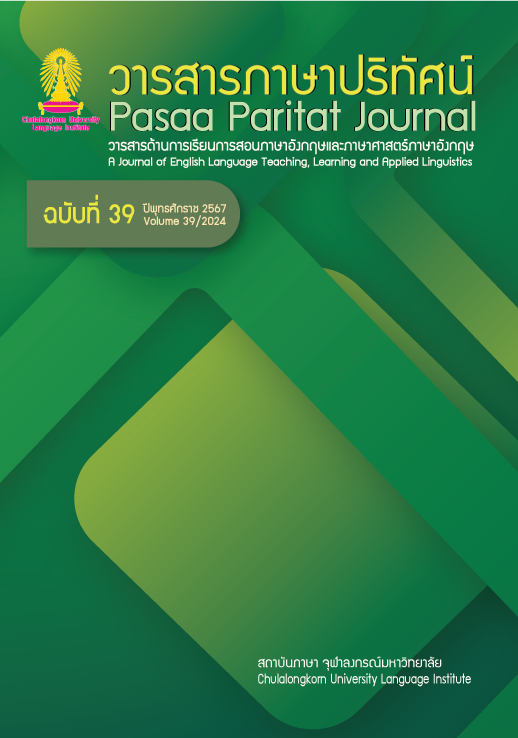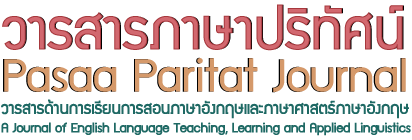ผลการจัดการเรียนการสอนภาษาอังกฤษด้วยกรณีศึกษาเพื่อพัฒนาทักษะการคิดเชิงวิพากษ์ของนักศึกษาสาขาวิชาการจัดการโรงแรม มหาวิทยาลัยเอกชนในไทย
DOI:
https://doi.org/10.58837/CHULA.PPJ.39.12คำสำคัญ:
การคิดเชิงวิพากษ์, กรณีศึกษา, การเรียนการสอนภาษาอังกฤษ, ธุรกิจการโรงแรมบทคัดย่อ
ทักษะการคิดเชิงวิพากษ์นับเป็นทักษะที่สำคัญสำหรับบุคลากรด้านการโรงแรม ในการรับมือกับความท้าทายต่างๆ ที่อาจเกิดขึ้นในสถานประกอบการ อย่างไรก็ตาม การจัดการเรียนการสอนรูปแบบเดิมที่เกิดขึ้นในประเทศไทยในระยะที่ผ่านมานี้ ยังค่อนข้างขาดการส่งเสริมการพัฒนาทักษะดังกล่าวให้กับผู้เรียนในสาขาวิชาชีพการโรงแรม ดังนั้นงานวิจัยนี้จึงมีวัตถุประสงค์เพื่อศึกษาประสิทธิผลในการจัดการเรียนการสอนด้วยกรณีศึกษาเพื่อพัฒนาทักษะการคิดเชิงวิพากษ์ของผู้เรียนในรายวิชาการสื่อสารภาษาอังกฤษขั้นสูงในธุรกิจโรงแรม โดยมีกลุ่มตัวอย่างเป็นนักศึกษามหาวิทยาลัยเอกชนระดับชั้นปีที่ 3 และ 4 สาขาวิชาการโรงแรมและภัตตาคาร ผลการศึกษาจากแบบสอบถามและการสัมภาษณ์แสดงให้เห็นว่าการจัดการเรียนการสอนด้วยกรณีศึกษามีส่วนช่วยพัฒนาทักษะการคิดเชิงวิพากษ์ให้กับนักศึกษาในเชิงบวก นอกจากนี้รูปแบบการเรียนการสอนดังกล่าว ยังมีส่วนช่วยพัฒนาทักษะการประเมิน (evaluating) และการสร้างสรรค์องค์ความรู้ใหม่ (creating) ซึ่งเป็นระดับขั้นสูงสุดของการเรียนรู้ตามทฤษฎี Bloom’s 2001 ดังนั้นการบูรณาการการสอนโดยใช้กรณีศึกษา และการฝึกอบรมครูผู้สอนในการจัดการเรียนการสอนด้วยวิธีดังกล่าว จึงนับเป็นสิ่งสำคัญที่จะช่วยส่งเสริมการพัฒนากระบวนการคิดเชิงวิพากษ์และเตรียมความพร้อมสู่สายอาชีพในอนาคตให้กับผู้เรียน
เอกสารอ้างอิง
Agwu, E. (2020, January 5). Use of case studies and critical thinking for teaching effectiveness – Examples from the School of Business [PowerPoint presentation] SlideServe. https://www.slideserve.com/rmohr/dr-edwin-agwu-powerpoint-ppt-presentation
Anderson, L. W., & Krathwohl, D. R. (2001). A Taxonomy for learning, teaching, and assessing: A revision of Bloom’s taxonomy of educational objectives. Longman.
ASEAN Tourism Professional Registration System (n.d.). https://www.dot.go.th/pages/149
Auttawutikul, S., Wiwitkunkasem, K., & Smith, D. R. (2014). Use of weblogs to enhance group learning and design creativity amongst students at a Thai university. Innovations in Education and Teaching International, 51(4), 378–388. https://doi.org/10.1080/14703297.2013.796723
Barnes, L. B., Christensen, C. R., & Hansen, A. J. (1994). Teaching and the case method: Text, cases, and readings. Harvard Business Press.
Barron, P. E., & Arcodia, C. (2002). Linking learning style preferences and ethnicity: International students studying hospitality and tourism management in Australia. Journal of Hospitality, Leisure, Sports and Tourism Education, 1(2), 15–27. https://doi.org/10.3794/JOHLSTE.12.25
Baumberger-Henry, M. (2003). Practicing the art of nursing through student-designed continuing case study and cooperative learning. Nurse Education, 28(4), 191–195. https://doi.org/10.1097/00006223-200307000-00011
Bettencourt, L. A. (2004). Change-oriented organizational citizenship behaviors: The direct and moderating influence of goal orientation. Journal of Retailing, 80(3), 165–180. https://doi.org/0.1108/IJOA-10-2014-0805
Boa, E. A., Wattanatorn, A., & Tagong, K. (2018). The development and validation of the Blended Socratic Method of Teaching (BSMT): An instructional model to enhance critical thinking skills of undergraduate business students. Kasetsart Journal of Social Sciences, 39(1), 81–89. https://doi.org/10.1016/j.kjss.2018.01.001
Byram, M. (2008). From foreign language education to education for intercultural citizenship: Essays and reflections. Multilingual Matters. https://doi.org/10.21832/9781847690807
Campbell, E. T. (2004). Meeting practice challenges via a clinical decision-making course. Nurse Educator, 29, 195–198. https://doi.org/10.1097/00006223-200409000-00010
Changwong, K., Sukkamart, A., & Sisan, B. (2018). Critical thinking skill development: Analysis of a new learning management model for Thai high schools. Journal of International Studies, 11(2), 37–48. https://doi.org/10.14254/2071-8330.2018/11-2/3
Charoensuthipan, P. (2023, December 7). Pisa results panic scholars. https://www.bangkokpost.com/thailand/general/2699879
Cho, J. Y., & Lee, E. (2014). Reducing confusion about grounded theory and qualitative content analysis: Similarities and differences. The Qualitative Report, 19(32), 1–20. https://doi.org/10.46743/2160-3715/2014.1028
Clark, D. J., Hott, J. (2001). Philosophy: A key to open the door to critical thinking. Nurse Education Today, 21(1), 71–78. https://doi.org/10.1054/nedt.2000.0512
Department of Tourism. (n.d.). ASEAN Tourism Professional Registration System. https://www.dot.go.th/pages/149
Dowd, S. B., & Davidhizar, R. (1999). Using case studies to teach clinical problem-solving. Nurse Educator, 24(5), 42–46. https://doi.org/10.1097/00006223-199909000-00017
Dredger, K. S., & Lehman, B. (2020). Dialogic multimodal paired presentations: Examining perspective. The Virginia English Journal, 69(2), 8–17.
Duan, W. (2020). On the Flipped classroom teaching model through task-based language teaching from the perspective of constructivist learning theory: A case of hotel English reform in Yinxing hospitality management college of CUIT. Asian research on English for specific purposes: Proceedings of the first symposium on Asia English for specific purposes, 2017 (pp. 209–227). Springer. https://doi.org/10.1007/978-981-15-1037-3_13
Falkenberg, L., & Woiceshyn, J. (2008). Enhancing business ethics: Using cases to teach moral reasoning. Journal of Business Ethics, 79(3), 213–217. https://doi.org/10.1007/s10551-007-9381-9
Feinstein, A. H. (2001). An assessment of the effectiveness of simulation as an instructional system in food service. Journal of Hospitality & Tourism Research, 25(4), 421–443. https://doi.org/10.1177/109634800102500405
Goffin, K., & New, C. (2001). Customer support and new product development: An exploratory study. International Journal of Operations & Production Management, 21(3), 275–301. https://doi.org/10.1108/01443570110364605
Halpern, D. F. (2001). Assessing the effectiveness of critical thinking instruction. The Journal of General Education, 50(4), 270–286. https://doi.org/10.1353/jge.2001.0024
Herreid, C. F. (2011). Case study teaching. New Directions for Teaching and Learning, 2011(128), 31–40. https://doi.org/10.1002/tl.466
Kanokpermpoon, M. (2019). Thinking skills in practice: A case study of an English curriculum at a Thai University. LEARN Journal: Language Education and Acquisition Research Network, 12(2), 49–63. https://so04.tci-thaijo.org/index.php/LEARN/article/view/205068/142769
Kinnear, L. C., & Ruggunan, S. (2019). Applying duoethnography to position researcher identity in management research. SA Journal of Human Resource Management, 17(1), 1–11. https://doi.org/10.4102/sajhrm.v17i0.1056
Kokebayevaa, G., & Kartabayevaa, Y. (2015). Application of case- technology for development of critical thinking ability of students. Procedia - Social and Behavioral Sciences, 171, 284–288. https://doi.org/10.1016/j.sbspro.2015.01.123
Kosawanon, S., Rungamornrat, S., & Panbangpra, S. (2015). Effect of case study teaching method on critical thinking in nursing students. Nursing Science Journal of Thailand, 33(3), 99–108. https://he02.tcithaijo.org/index.php/ns/article/view/53202
Lashley, C., & Barron, P. (2006). The learning style preferences of hospitality and tourism students: Observations from an international and cross-cultural study. International Journal of Hospitality Management, 25(4), 552–569. http://doi.org/10.1016/j.ijhm.2005.03.006
Leenders, M. R., Mauffette-Leenders, L. A., & Erskine, J. A. (2001). Writing cases (4th ed.). Ivey.
Mahdi, O. R., Nassar, I. A., & Almuslamani, H. A. I. (2020). The role of using case studies method in improving students’ critical thinking skills in higher education. International Journal of Higher Education, 9(2), 297–308. https://doi.org/10.5430/ijhe.v9n2p297
Malthouse, R., Watts, M., & Roffey-Barentsen, J. (2015). Reflective questions, self-questioning and managing professionally situated practice. Research in Education, 94(1), 71–87. https://doi.org/10.7227/RIE.0024
Maxwell, J. A. (2012). Qualitative research design: An interactive approach (3rd ed). Sage.
Merriam, S. B., & Tisdell, E. J. (2015). Qualitative research: A guide to design and implementation. (4th ed.). John Wiley & Sons.
Ministry of Higher Education, Science, Research and Innovation (MHESI). (n.d.). List of accredited Thai higher education institutions under MHESI. https://www.ops.go.th/en/inter-about-ops-mhesi/higher-education/download/2870/5708/16
Mustika, N., Nurkamto, J., & Suparno, S. (2020). Influence of questioning techniques in EFL classes on developing students’ critical thinking skills. International Online Journal of Education and Teaching, 7(1), 278–287. http://files.eric.ed.gov/fulltext/EJ1244255.pdf
Norton, L., & Sliep, Y. (2018). A critical reflexive model: Working with life stories in health promotion education. South African Journal of Higher Education, 32(3), 45–63. https://doi.org/10.20853/32-3-2523
Paltridge, B., & Starfield, S. (2013). The handbook of English for specific purposes (Vol. 592). John Wiley & Sons.
Ploysangwal, W. (2018). An assessment of critical thinking skills of Thai undergraduate students in private Thai universities in Bangkok through an analytical and critical reading test. The Journal of the University of the Thai Chamber of Commerce in Humanities and Social Sciences, 38(3), 75–91. https://so06.tci-thaijo.org/index.php/utccjournalhs/article/view/158002/114426
Popil, I. (2011). Promotion of critical thinking by using case studies as teaching method. Nurse Education Today, 31(2), 204–207. https://doi.org/10.1016/j.nedt.2010.06.002
Raub, S., & Liao, H. (2012). Doing the right thing without being told: Joint effects of initiative climate and general self-efficacy on employee proactive customer service performance. Journal of Applied Psychology, 97(3), 651–667. https://doi.org/10.1037/a0026736
Richardson, B. (1993). Why we need to teach crisis management and to use case studies to do it. Management Education and Development, 24(2), 138–148. https://doi.org/10.1177/135050769302400203
Roy, S., & Banerjee, P. (2012). Understanding students’ experience of transition from lecture mode to case-based teaching in a management school in India. Journal of Educational Change, 13(4), 487–509. https://doi.org/10.1007/s10833-012-9191-4
Saldana, J. (2014). Coding and analysis strategies. In P. Leavy & J. Saldana (Eds.), The Oxford handbook of qualitative research (pp. 581–685). Oxford University Press.
Steiner, G., & Posch, A. (2006). Higher education for sustainability by means of transdisciplinary case studies: An innovative approach for solving complex, real-world problems. Journal of Cleaner Production, 14(9–11), 877–890. https://doi.org/10.1016/j.jclepro.2005.11.054
Thomas, L. (2009). From experience to meaning: The critical skills program. Phi Delta Kappan, 91(2), 93–96. https://doi.org/10.1177/003172170909100224
ดาวน์โหลด
เผยแพร่แล้ว
รูปแบบการอ้างอิง
ฉบับ
ประเภทบทความ
สัญญาอนุญาต
ลิขสิทธิ์ (c) 2024 วารสารภาษาปริทัศน์

อนุญาตภายใต้เงื่อนไข Creative Commons Attribution-NonCommercial-NoDerivatives 4.0 International License.



